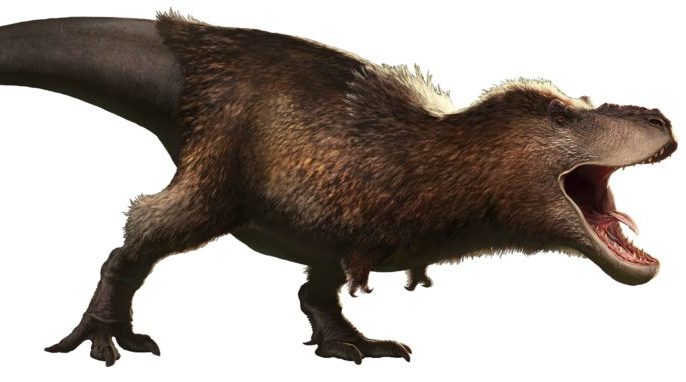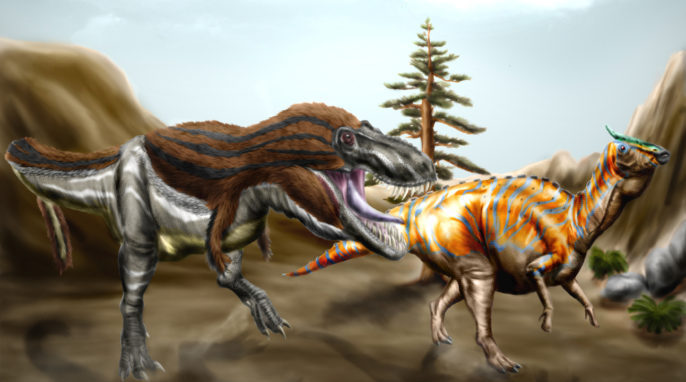Which Dinosaur Gave Rise to Tyrannosaurus Rex?
What dinosaur was the ancestor of the mighty Tyrannosaurus rex? Which dinosaur gave rise to this famous lineage?
By David Blagic
Tyrannosaurus rex surely is one of the most well-known dinosaurs of all time. We know nearly everything about it, from its anatomy to its behavior. However, one important question hasn’t yet been answered—who was T. rex’s ancestor? What dinosaur species has the honor to be called “the King’s” grandparent?
There are three main contestants: (1) Tarbosaurus bataar, (2) southern-type North American tyrannosaurid, or (3) Daspletosaurus torosus.
Tarbosaurus bataar
Tarbosaurus is probably the closest relative of Tyrannosaurus discovered so far. The only notable morphological differences between it and Tyrannosaurus are that Tarbosaurus has proportionally smaller front limbs (yes, there are dinosaur species with even smaller arms than T. rex), a proportionally longer and narrower skull (resulting in eye sockets that are further back in the skull, giving Tarbosaurus a considerably smaller field of binocular vision), and a less massive body. The fact that these two animals are so similar has led some paleontologists to conclude that Tarbosaurus may just be a junior synonym of Tyrannosaurus, although not many agree with this hypothesis today.
Tarbosaurus remains were excavated from the Nemegt formation in Mongolia. All specimens are dated to be approximately 70 million years old, or slightly less. The oldest definitive T. rex specimens are 68 million years old.
According to a study from 2013 by paleontologist Steve Brusatte, Tyrannosaurus rex was most likely an invasive species in North America, probably arriving from Asia. This idea is correspondent with the hypothesis proposed by paleontologist Phil Currie that Tyrannosaurus’s ancestor was actually Tarbosaurus.
Southern-type North American tyrannosaurid
There were two types of tyrannosaurids in North America—the northern type (including Albertosaurus, Gorgosaurus, and Daspletosaurus) and the southern type (including Teratophoneus and Lythronax). Tyrannosaurids on the northern part of the continent possessed a ridge on their fourth metatarsal bones (bones that together with tarsi make up the upper foot), while those on the southern part did not. This indicates that these two groups separated at one point in time and started developing different characteristics.
According to paleontologist Tracy Thomson, Tyrannosaurus rex originated from one of these southern North American tyrannosaurid species, probably closely related to the relatively recently found Lythronax argestes.
RELATED: SHELF LIFE VIDEO: THE DINOSAURS OF GHOST RANCH
Daspletosaurus torosus
Daspletosaurus torosus is most widely accepted as the direct ancestor to Tyrannosaurus rex. The only notable differences between the two are that Daspletosaurus possesses proportionally larger teeth, longer arms, and smaller feet, and is overall more muscular and heavily built than Tyrannosaurus. Its fossils can be found in Alberta and Montana and come from a period between 77 and 74 million years BCE.
Daspletosaurus’s eye socket represents a link between the more basal eye sockets seen in Albertosaurinae tyrannosaurids and the ones seen in Tyranosaurus. Albertosaurinae have very simple circular eye sockets, while Tyrannosaurus’s eye socket is like a keyhole—basically elliptical but divided in two by a small spike growing out of the postorbital bone. Daspletosaurus’s eye socket is elliptical but isn’t divided.
RELATED: DISCOVERING DEINONYCHUS
In his study from 1988, paleontologist Gregory S. Paul first suggested that Tyrannosaurus rex evolved from Daspletosaurus torosus through anagenesis, a process in which an entire species gradually transforms. That would really make Daspletosaurus just a junior synonym of Tyrannosaurus and name a new species in the process—Tyrannosaurus torosus. Paleontologist Jack Horner later found two to three specimens of tyrannosaurids in the Two Medicine formation in Montana and, in his study from 1992, described them as “evolutionary links between Daspletosaurus and Tyrannosaurus,” confirming the anagenesis theory. These were dated to be 75 to 74 million years old and later identified by Currie to be the “third species of Daspletosaurus.”


Putting the pieces together
During the 1990s, a small bone called the lacrimal (a bone separating antorbital fenestra from the eye socket) was found in the Judith River formation in Montana, but it was quickly forgotten. It was found in the circa 75-million-year-old sediments from the late Cretaceous period. Only later, in 2006, would paleontologists Urban and Lamanna finally describe the lacrimal and provisionally identify it as belonging to Tyrannosaurus—making it the earliest Tyrannosaurus specimen known to date, if it can be confirmed to belong to Tyrannosaurus. Although Urban and Lamanna do show compelling evidence, the specimen is fragmentary, as it consists of a single bone.
Let’s just note the parallels between Horner’s Daspletosaurus specimens from the Two Medicine formation and this Tyrannosaurus specimen: both were found in Montana, both are from about the same time period, and both are described as potential ancestors of Tyrannosaurus.
RELATED: DINOSAUR FOSSILS OF GHOST RANCH
If Urban and Lamanna’s specimen was really a Tyrannosaurus, that would ultimately discredit Tarbosaurus as a possible ancestor of Tyrannosaurus, because its oldest fossils are dated to be about 70 million years old, 5 million years younger than the first potential Tyrannosaurus.
I think we have the winner here. It seems to me that Daspletosaurus is most likely to be the ancestor to Tyrannosaurus rex, and some paleontologists agree.
References
Currie, Philip J. (2003). “Cranial anatomy of tyrannosaurids from the Late Cretaceous of Alberta,” Acta Palaeontologica Polonica.
Geggel, Laura (2016). “T. rex Was Likely an Invasive Species,” Livescience.
Horner, John R.; Varricchio, David J.; Goodwin, Mark B. (1992). “Marine transgressions and the evolution of Cretaceous dinosaurs,” Nature.
Michael, A.; Lamanna, Matther C. (2006). “Evidence of a giant tyrannosaurid (Dinosauria: Theropoda) from the upper Cretaceous (?Campanian) of Montana,” Annals of Carnegie Museum.
Paul, Gregory S. (1988). Predatory Dinosaurs of the World, New York: Simon & Schuster.
Thomson, T., Irmis, R., Loewen, M. (2013). “First occurrence of a tyrannosaurid dinosaur from the Mesaverde Group (Neslen Formation) of Utah: Implications for upper Campanian Laramidian biogeography,” Cretaceous Research.
Featured image: The tyrannosaurid Tarbosaurus baatar pursuing the hadrosaurine Saurolophus angustirostris. Credit: Durbed via Wikimedia Commons.
—David is a young, amateur paleontologist and student of vertebrate paleontology who lives in Serbia. He enjoys learning about the behavior, morphology, phylogeny, and evolution of dinosaurs, particularly Theropods such as Maniraptorans and Carnosaurs.




